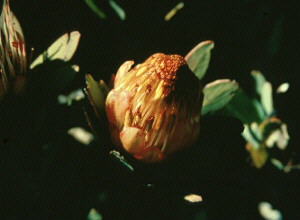
Home
Mission
Overview of Project
Project Staff
Sponsors
Achievements
Checking, Illustrations
Upcoming Activities
Id and Species Lists
Protea Information
Protea Gallery
Growing Proteas
Interim Dist. Maps
Publications
Afrikaanse Inligting
![]()
A Walk in the Clouds
 It's with thanks to Natal
Parks Board rangers Simon Sibeko and Alfred Sigubudu that I was able to climb to and
locate Protea nubigena (SASOL Proteas: 31) during my stay at Royal Natal National
Park in late December last year. We left Tendele camp at 06h30. Grateful for the early
morning coolness we headed up the Vemvaan George (Vemvaan is a Zulu name given to many
flying insects, but specifically to the Preying Mantis). The walk to the falls is gentle
and follows a well-maintained path that winds its way through fields of Protea caffra
caffra.
It's with thanks to Natal
Parks Board rangers Simon Sibeko and Alfred Sigubudu that I was able to climb to and
locate Protea nubigena (SASOL Proteas: 31) during my stay at Royal Natal National
Park in late December last year. We left Tendele camp at 06h30. Grateful for the early
morning coolness we headed up the Vemvaan George (Vemvaan is a Zulu name given to many
flying insects, but specifically to the Preying Mantis). The walk to the falls is gentle
and follows a well-maintained path that winds its way through fields of Protea caffra
caffra.
At the Vemvaan falls we scrambled out of the forest and headed for the spine of Policeman's Helmet ridge. The slopes were in places near vertical and care had to be taken not to lose our footing and risk sliding back down to our starting point. This was the steepest section of the climb to Pr nubigena.
I have for a long time wondered what had inspired Elsie Esterhuisen to climb the base of the Witches way back in July 1964. As I slogged my way up the ridge I realised what, besides the magnificent views, must have drawn her up the ridge: the grasslands were rich with wild flowers.
Policeman's Helmet ridge forms the western face to the Tugela George. From the top of the ridge we got magnificent views down the sheer cliffs into the Tugela George, and to the west the grassy slopes plummeted into the Vemvaan catchment. Sandstone gave way to basalt at around 2 000 m. We continued to climb recording only Pr dracomantana, Pr caffra caffra having dropped away just before the change to basalt. One of the stranger wildflowers that we encountered as we climbed higher was the Natal Slangkop Urginea macrocentra.
We rested at a thumb of rock that divides the ridge and the precarious slopes leading up to the Witches. The clouds that swirled around us lifted so I was able to scan the slopes above for likely habitat. In the distance were some proteas which were the only likely candidates, though they did not fit the description of Pr nubigena. Unfortunately neither of my fellow climbers had been to the site before and they were working from directions given to them by the Induna who had accompanied others there some thirteen years ago. From what we could make out we needed to climb a little higher to where the slopes became more precarious. This gave me hope as I recalled John Rourke's account of his trip to collect herbarium specimens. On the steeper moister slopes to the west and above the seeps we found a very scattered population of Pr dracomantana. The growth habit was not typical, but undoubtedly was Pr dracomantana. What was also of interest was the rootstock being more rhizomatous than a woody plate, as was characteristic on the lower slopes. The stem growth was also lanky, as opposed to the stout stems typical of the lower slopes.
We crisis-crossed (!Eds) the precarious slopes until we came to a saddle at about 2600 m, at the top of the P. dracomantana population. Here we lunched in the swirling clouds and, though firmly plonked on the ground, I had an eerie feel of motion. Revitalised, we resume our search for the Cloud Protea, finally reaching the wall of the Witches where our path was blocked.
It was decided that we would descend by different routes and meet up at the Thumb of rock. I chose the most easterly ridge. On descending I wondered to myself why I had chosen to climb this particularly exposed route. The answer was there in front of me, the famed population of P. nubigena. So I was not to go home defeated.
Protea nubigena occupies what must be the most spectacular spot of all southern Africa's proteas. Below the steep cliffs, which my ranger friends forbade me to climb down, sweeps the Tugela George and towering above the sheer rock walls of the Amphitheatre. The question as to why this protea occurs here - and only here - is frequently asked, as it is with many other narrow endemics. With the Cloud Protea I feel that the vistas justify the locality: who would want to swap this for sandy flats where one is always under the threat of the "Urban Creep".
Nicholas Cole
Cloud Sugarbush - Protea nubigena
Back PAN 30
